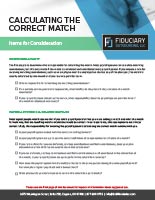
The Story
Mayberry Shades, Inc. has a 401(k) plan with a match of 100% of the first 3% of pay someone saves. Joe, the CFO, elected to defer $500 into the plan each pay period. Mayberry has 24 payrolls a year and deposits the match each pay period. Joe made exactly $200,000 in 2015. He was expecting to see $12,000 in 401(k) deferrals and $6,000 in match go into his 401(k) account in 2015, but that isn’t what happened.
Joe was paid $150,000 in base pay and $50,000 in bonus pay. His end of year bonus was issued as a separate check from his base paycheck. Mayberry’s payroll system is programmed to take deferrals out of the first check written during a payroll period with no deferrals from any other checks that period. It also calculates the match on a check by check basis.
So here’s what Joe’s paychecks looked like during the year:
|
For the 24 regular pay paychecks: |
For the 1 bonus paycheck: |
| Gross pay: $6,250 | Gross pay: $50,000 |
| 401(k): $500 | 401(k): $0 |
| Match: $187.50 |
Match: $0 |
Total match: $187.50 x 24 = $4,500
The payroll folks at Mayberry didn’t realize that the payroll system was coded in this manner, so when Joe asked why his match was only $4,500 for the year instead of $6,000, no one knew the answer. Eventually it was discovered that no employee should be set up with more than one paycheck in a payroll period. Only then would the match be correct.
How did they fix it
Joe had an audit completed for the last two years and it turns out that only 3 of the employees of Mayberry, a 3,000 employee company, had received two paychecks on the same payroll date. Therefore, under the IRS rules, this was considered a self-correctable error in that it affected a very small number of employees for a very small dollar amount. As a result, Mayberry deposited the missed match to the affected participants and trained all payroll staff that they should never create two checks inside their payroll system for the same payroll date.
Never again!
Joe, in his position as CFO, was concerned that Mayberry had set up its payroll system unaware of this multiple paycheck issue. After discussions with the payroll department, Joe determined his staff didn’t have the retirement plan expertise to know if they were coding the payroll system correctly or not. Joe discussed this issue with his service provider team and ultimately decided to retain Fiduciary Outsourcing’s services to oversee the setup of the payroll system as it relates to the retirement plan.

The Mistake
The plan’s document defines how match should be calculated. It defines the formula to use to determine the amount of match each participant receives. It defines the time frame to use in the calculation (i.e. each payroll period or the plan year). It also defines who receives the match. It may define the timing by which the matching contributions must be made. It certainly defines the compensation to be used to calculate the match.
If the match is calculated by the payroll system, the payroll system needs to be coded correctly. Does the payroll system use the correct definition of compensation? Does it include the correct deferrals? Sometimes plans don’t match on catch up contributions. Sometimes plans don’t match on Roth deferrals. Is the payroll system coded correctly?
If the match is calculated at the end of a specified period such as the end of a quarter or the end of the plan year, who is responsible for the calculation? Is that party provided with the correct deferrals and compensation information?
What about determining which employees get the match? Who is responsible for this determination? Is the correct data provided to that person or service provider? Is the payroll system coded correctly to produce the correct data?
As you can see, there are lots of ways in which something can be missed resulting in the match being calculated incorrectly.

What Happens
If you determine you have been calculating match incorrectly, first thing to do is fix it going forward. Next, you must decide how to deal with the past.
The IRS requires you to return the plan to position it would have been in if the mistake hadn’t occurred. In other words, if you haven’t contributed enough matching contributions to someone, you must make up the difference. If you have over-contributed, you must decide what to do with the excess amount. And, any amounts need to be adjusted for earnings through the date of correction.
The exact rules on how to fix this error are found in IRS Revenue Procedure 2013-12. You will want to consult with a retirement plan professional who does plan corrections for assistance in determining exactly what adjustments to the matching contributions should be made.
If you find the error within 2 years of first making it OR if the error is considered insignificant, you can self-correct as long as you follow one of the correction methods outlined in the Revenue Procedure. However, if you find the error after 2 years and determine it’s significant, you must file with the IRS through their Voluntary Correction Program for permission to correct the plan. There is a user fee for the IRS program that varies based on the number of people in the plan.
Avoid it
There are two likely ways for a compensation mistake to occur:
- The person who calculates the match didn’t read the plan document; or
- The payroll system is coded incorrectly to provide the wrong data in the calculation of the match or the report of the data used to calculate the match.
Ensuring that whoever codes the matching contributions into the payroll system is critical if the match will be calculated by the payroll system. Check how compensation is defined in the plan document versus how the payroll system is set up. Check how the deferrals get calculated by the payroll system. Check how match gets calculated.
If a staff member or service provider will use reports from the payroll system to calculate the match, make sure that person has read the plan document. Then, check the payroll system is providing the right compensation and deferral information as this information will be critical to determine the correct matching contributions.
Either way, set up a process to review the payroll system setup and the method of calculating the match periodically to ensure everything is done properly.

How We Help
You have the ability to outsource your responsibilities as the Plan Administrator. As such, you can outsource the responsibility for auditing the payroll system to us and confirming the matching amounts. You can also outsource the review of any reports or data generated to us. We then assume a fiduciary responsibility with regard to the determination of the amount of matching contributions made to the plan.

Checklist
Download the items for consideration for calculating the correct match.


The Story
Mayberry Shades, Inc. has a 401(k) plan with a match of 100% of the first 3% of pay someone saves. Joe, the CFO, elected to defer $500 into the plan each pay period. Mayberry has 24 payrolls a year and deposits the match each pay period. Joe made exactly $200,000 in 2015. He was expecting to see $12,000 in 401(k) deferrals and $6,000 in match go into his 401(k) account in 2015, but that isn’t what happened.
Joe was paid $150,000 in base pay and $50,000 in bonus pay. His end of year bonus was issued as a separate check from his base paycheck. Mayberry’s payroll system is programmed to take deferrals out of the first check written during a payroll period with no deferrals from any other checks that period. It also calculates the match on a check by check basis.
So here’s what Joe’s paychecks looked like during the year:
For the 24 regular pay paychecks:
Gross pay: $6,250
401(k): $500
Match: $187.50
For the 1 bonus paycheck:
Gross pay: $50,000
401(k): $0
Match: $0
Total match: $187.50 x 24 = $4,500
The payroll folks at Mayberry didn’t realize that the payroll system was coded in this manner, so when Joe asked why his match was only $4,500 for the year instead of $6,000, no one knew the answer. Eventually it was discovered that no employee should be set up with more than one paycheck in a payroll period. Only then would the match be correct.
How did they fix it
Joe had an audit completed for the last two years and it turns out that only 3 of the employees of Mayberry, a 3,000 employee company, had received two paychecks on the same payroll date. Therefore, under the IRS rules, this was considered a self-correctable error in that it affected a very small number of employees for a very small dollar amount. As a result, Mayberry deposited the missed match to the affected participants and trained all payroll staff that they should never create two checks inside their payroll system for the same payroll date.
Never again!
Joe, in his position as CFO, was concerned that Mayberry had set up its payroll system unaware of this multiple paycheck issue. After discussions with the payroll department, Joe determined his staff didn’t have the retirement plan expertise to know if they were coding the payroll system correctly or not. Joe discussed this issue with his service provider team and ultimately decided to retain Fiduciary Outsourcing’s services to oversee the setup of the payroll system as it relates to the retirement plan.

The Mistake
The plan’s document defines how match should be calculated. It defines the formula to use to determine the amount of match each participant receives. It defines the time frame to use in the calculation (i.e. each payroll period or the plan year). It also defines who receives the match. It may define the timing by which the matching contributions must be made. It certainly defines the compensation to be used to calculate the match.
If the match is calculated by the payroll system, the payroll system needs to be coded correctly. Does the payroll system use the correct definition of compensation? Does it include the correct deferrals? Sometimes plans don’t match on catch up contributions. Sometimes plans don’t match on Roth deferrals. Is the payroll system coded correctly?
If the match is calculated at the end of a specified period such as the end of a quarter or the end of the plan year, who is responsible for the calculation? Is that party provided with the correct deferrals and compensation information?
What about determining which employees get the match? Who is responsible for this determination? Is the correct data provided to that person or service provider? Is the payroll system coded correctly to produce the correct data?
As you can see, there are lots of ways in which something can be missed resulting in the match being calculated incorrectly.

What Happens
If you determine you have been calculating match incorrectly, first thing to do is fix it going forward. Next, you must decide how to deal with the past.
The IRS requires you to return the plan to position it would have been in if the mistake hadn’t occurred. In other words, if you haven’t contributed enough matching contributions to someone, you must make up the difference. If you have over-contributed, you must decide what to do with the excess amount. And, any amounts need to be adjusted for earnings through the date of correction.
The exact rules on how to fix this error are found in IRS Revenue Procedure 2013-12. You will want to consult with a retirement plan professional who does plan corrections for assistance in determining exactly what adjustments to the matching contributions should be made.
If you find the error within 2 years of first making it OR if the error is considered insignificant, you can self-correct as long as you follow one of the correction methods outlined in the Revenue Procedure. However, if you find the error after 2 years and determine it’s significant, you must file with the IRS through their Voluntary Correction Program for permission to correct the plan. There is a user fee for the IRS program that varies based on the number of people in the plan.
Avoid it
There are two likely ways for a compensation mistake to occur:
- The person who calculates the match didn’t read the plan document; or
- The payroll system is coded incorrectly to provide the wrong data in the calculation of the match or the report of the data used to calculate the match.
Ensuring that whoever codes the matching contributions into the payroll system is critical if the match will be calculated by the payroll system. Check how compensation is defined in the plan document versus how the payroll system is set up. Check how the deferrals get calculated by the payroll system. Check how match gets calculated.
If a staff member or service provider will use reports from the payroll system to calculate the match, make sure that person has read the plan document. Then, check the payroll system is providing the right compensation and deferral information as this information will be critical to determine the correct matching contributions.
Either way, set up a process to review the payroll system setup and the method of calculating the match periodically to ensure everything is done properly.

How We Help
You have the ability to outsource your responsibilities as the Plan Administrator. As such, you can outsource the responsibility for auditing the payroll system to us and confirming the matching amounts. You can also outsource the review of any reports or data generated to us. We then assume a fiduciary responsibility with regard to the determination of the amount of matching contributions made to the plan.

Checklist
Download the items for consideration for calculating the correct match.

